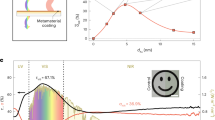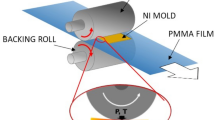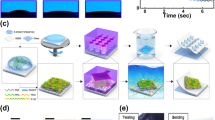Abstract
For nearly two centuries, researchers have sought novel methods to increase light transmission in optical systems, as well as to eliminate unwanted reflections and glare. Anti-reflection coatings and surfaces have enabled the increasing performance demands of optical components fabricated from glass-based optical materials. With the current trend of technology moving towards optically transparent polymeric media and coatings, the need for anti-reflection technology and environmentally benign processing methods for polymeric materials independent of shape or size has become quite apparent. We describe an economical, aqueous-based process controlled at the molecular level that simultaneously coats all surfaces of almost any material. Systematically designed nanoporous polymer films are used, which are suitable for optical applications operating at both visible and near-infrared wavelengths. These high-efficiency anti-reflection coatings are created from phase-separated polyelectrolyte multilayer films that undergo a reversible pH-induced swelling transition. Furthermore, such films, easily patterned by an inkjet printing technique, possess potential for pH-responsive biomaterial and membrane applications.
This is a preview of subscription content, access via your institution
Access options
Subscribe to this journal
Receive 12 print issues and online access
$259.00 per year
only $21.58 per issue
Buy this article
- Purchase on Springer Link
- Instant access to full article PDF
Prices may be subject to local taxes which are calculated during checkout






Similar content being viewed by others
References
Macleod, H.A. Thin-Film Optical Filters (Elsevier, New York, 1969).
Mark, J.E. (ed.) Polymer Data Handbook (Oxford Univ. Press, New York, 1999).
Yoldas, B.E. Investigations of porous oxides as an antireflective coating for glass surfaces. Appl. Opt. 19, 1425–1429 (1980).
Minot, M.J. Single-layer, gradient refractive index antireflection films effective from 0.35 to 2.5 microns. J. Opt. Soc. Am. 66, 515–519 (1976).
Clapham, P.B. & Hutley, M.C. Reduction of lens reflexion by the 'Moth Eye' principle. Nature 244, 281–282 (1973).
Fraunhofer, J. Versuche über die Ursachen des Anlaufens und Mattwerdens des Glases und die Mittel, denselben zuvorzukommen 33–49 (Joseph von Fraunhofer's Gesammelte Schriften, Munich, 1888).
Uhlmann, D.R., Suratwala, T., Davidson, K., Boulton, J.M. & Teowee, G. Sol-gel derived coatings on glass. J. Non-Cryst. Solids 218, 113–122 (1997).
Hattori, H. Anti-reflection surface with particle coating deposited by electrostatic attraction. Adv. Mater. 13, 51–54 (2001).
Walheim, S., Schäffer, E., Mlynek, J. & Steiner, U. Nanophase-separated polymer films as high-performance antireflection coatings. Science 283, 520–522 (1999).
Ibn-Elhaj, M. & Schadt, M. Optical polymer thin films with isotropic and anisotropic nano-corrugated surface topologies. Nature 410, 796–799 (2001).
Decher, G., Hong, J.D. & Schmitt, J. Buildup of ultrathin multilayer films by a self-assembly process III. Consecutively alternating adsorption of anionic and cationic polyelectrolytes on charged surfaces. Thin Solid Films 210, 831–835 (1992).
Decher, G. Fuzzy nanoassemblies: toward layered polymeric multicomposites. Science 277, 1232 (1997).
Ferreira, M., Cheung, J.H. & Rubner, M.F. Molecular self-assembly of conjugated polyions – a new process for fabricating multilayer thin-film heterostructures. Thin Solid Films 244, 806–809 (1994).
Shiratori, S.S. & Rubner, M.F. pH-Dependent thickness behavior of sequentially adsorbed layers of weak polyelectrolytes. Macromolecules 33, 4213–4219 (2000).
Calvert, P. Inkjet printing for materials and devices. Chem. Mater. 13, 3299–3305 (2001).
Wang, T.C., Chen, B., Rubner, M.F. & Cohen, R.E. Selective electroless nickel plating on polyelectrolyte multilayer platforms. Langmuir 17, 6610–6615 (2001).
Yang, S.Y. & Rubner, M.F. Micropatterning of polymer thin films with pH-sensitive and cross-linkable hydrogen-bonded polyelectrolyte multilayers. J. Am. Chem. Soc. 124, 2100–2101 (2002).
Mendelsohn, J.D. et al. Fabrication of microporous thin films from polyelectrolyte multilayers. Langmuir 16, 5017–5023 (2000).
Fery, A., Scholer, B., Cassagneau, T. & Caruso, F. Nanoporous thin films formed by salt-induced structural changes in multilayers of poly(acrylic acid) and poly(allylamine). Langmuir 17, 3779–3783 (2001).
Zhang, H. & Ito, Y. in Handbook of Polyelectrolytes and Their Applications Vol. I (eds Tripathy, S.K., Kumar, J. & Nalwa, S. S.) 183–197 (American Scientific, California, 2002).
Speir, J.A., Munshi, S., Wang, G.J., Baker, T.S. & Johnson, J.E. Structures of the native and swollen forms of cowpea chlorotic mottle virus determined by X-ray crystallography and cryo-electron microscopy. Structure 3, 63–78 (1995).
Douglas, T. & Young, M. Host–guest encapsulation of materials by assembled virus protein cages. Nature 393, 6681–6685 (1998).
Harris, J.J. DeRose, P.M. & Bruening, M.L. Synthesis of passivating, nylon-like coatings through cross-linking of ultrathin polyelectrolyte films. J. Am. Chem. Soc. 121, 1978–1979 (1999).
Monaco, S.F. Reflectance of an inhomogeneous thin film. J. Opt. Soc. Am. 51, 280–282 (1961).
Acknowledgements
We thank J.-F. Hiller for computational support. This research was supported financially by the MIT Center for Materials Science and Engineering and the National Science Foundation. J.H. acknowledges the Lucent Technologies Cooperative Research Fellowship Program.
Author information
Authors and Affiliations
Corresponding author
Ethics declarations
Competing interests
The authors declare no competing financial interests.
Rights and permissions
About this article
Cite this article
Hiller, J., Mendelsohn, J. & Rubner, M. Reversibly erasable nanoporous anti-reflection coatings from polyelectrolyte multilayers. Nature Mater 1, 59–63 (2002). https://doi.org/10.1038/nmat719
Received:
Accepted:
Published:
Issue Date:
DOI: https://doi.org/10.1038/nmat719
This article is cited by
-
Electrical and dielectric properties of RF sputtered nano Al2O3 film annealed at 400 °C
Journal of Materials Science: Materials in Electronics (2023)
-
Multi-functional hydrogel electrodes for emerging electronic and robotic applications
Korean Journal of Chemical Engineering (2023)
-
Preparing high chroma colored silica nanoparticles based on layer-by-layer self-assembled technique
Journal of Sol-Gel Science and Technology (2022)
-
Surface morphologies and wetting properties of layer-by-layer assembled films of polyelectrolytes with bimodal molecular weight distribution
Korean Journal of Chemical Engineering (2020)
-
Metallo-polyelectrolytes as a class of ionic macromolecules for functional materials
Nature Communications (2018)



